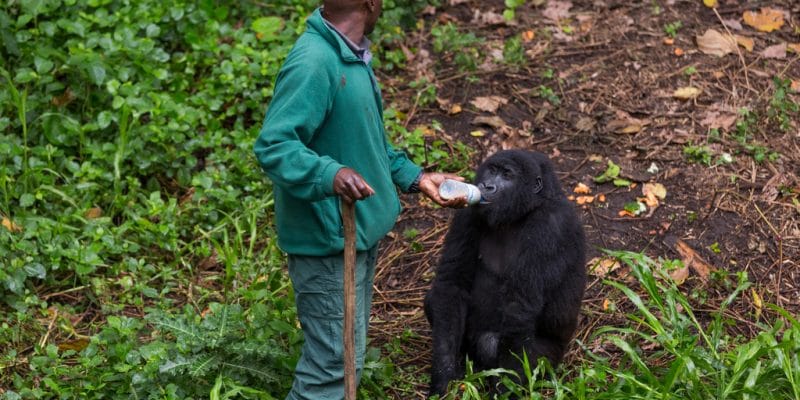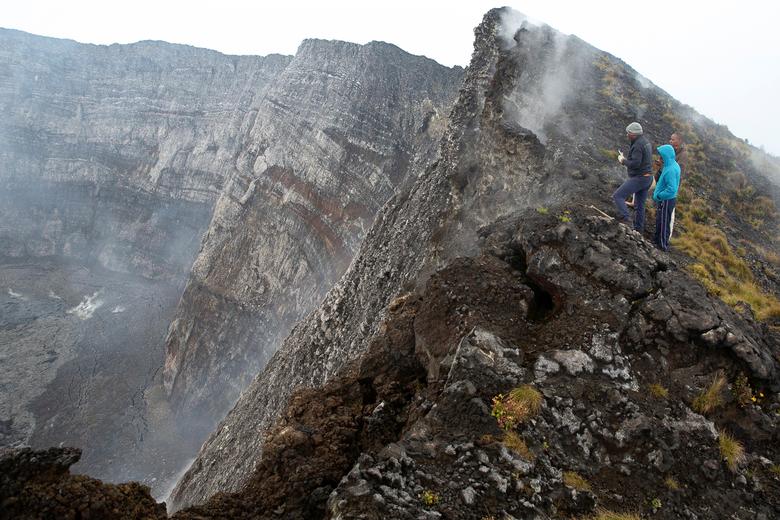Virunga National Park Congo
Virunga National Park (VNP) a designated UNESCO World Heritage Site is arguably one of Africa’s most biologically diverse protected areas. Lying suitably along the Albertine Rift Valley, Virunga National Park is noted for its incredible wildlife and range of habitats. Visit Virunga National Park Congo to explore, experience one of the world’s most bio-diverse conservation areas.
Virunga National Park stands out as one of the very few best destinations in the world that offer lifetime mountain gorilla trekking experiences. Virunga was officially designated as Congo National Park in 1925 making it the oldest park in Africa and it was gazetted primarily to house a section of the endangered mountain gorillas whose population remains less than 1063 individuals today.

Mountain Gorillas in Virunga National Park
Size: Virunga National Park Congo is, without doubt, one of the biggest parks not only in the D.R. Congo but also in Africa. Virunga NP sits on a vast land area of over 7800sq.km, Eastern D.R. Congo protecting the diversity of habitats each hosting unique wildlife species, birds, flora to mention but a few.
Location of Virunga National Park
Virunga National Park (VNP) is found in the Eastern Democratic Republic of the Congo (DRC), on the Albertine Rift Valley. It is suitably lying in an area bordering the Semuliki River Basin to the North-a portion of which is covered by Virunga. The 7800sq.km park sits on an elevation range of 680-5109m with its central section extending two-thirds of Lake Edward.
The Southern section of the Virunga National Park features Lake Kivu shores and protects 3 of the 8 Virunga Massifs or volcanoes-Mikeno Volcano, Nyiragongo, and Nyamulagira. The Northern section of Virunga links to some of Uganda’s pristine National Parks especially the Rwenzori Mountains National Park & Semuliki National Park whereas it’s Central Area extends towards Queen Elizabeth National Park.
History of Virunga National Park Congo
Virunga National Park Congo formerly Albert National Park was gazetted in 1925-reason for its creation was mainly to protect the rare mountain gorillas. At the time when Virunga was established as Albert National Park also comprising of the present Rwanda Volcanoes National Park, it protected only 3 volcanoes along the southern section. Later, its coverage increased towards the North encompassing the Rwindi Plains, Lake Edward area, and some parts of the Rwenzori Mountain ranges.
When the D.R. Congo gained its independence in 1960, the then Albert National Park was renamed as the Virunga National Park around 1969 and by 1979, it was declared as a UNESCO Site. The other side of Rwanda was named Volcanoes National Park and unlike Virunga, Volcanoes National Park has enjoyed peace and stability for a good time making it a favorite gorilla trekking spot for most travelers on Rwanda safaris. Gorilla tourism in the Virunga has been impacted by insecurities but a lot is still being done to make sure that peace is restored in this magical mountain gorilla spot.
The Wildlife in the Virunga National Park
Virunga National Park is a biologically rich park, protecting over 218 mammal species, 65 amphibian species, 109 reptile species, 706 bird species. The park is home to about 300 endangered mountain gorillas which also share the same habitat with other diverse primate species including Hamlyn’s monkeys, Okapis, Chimps, Golden monkeys, Blue monkeys, Central African red colobus monkeys, Grey-cheeked mangabeys, Mantled guereza. In addition, there are also Kobs, Yellow-backed duikers, Elephants, Hippos, Nile crocodiles, Bushbucks, Blue duikers, Giant forest hogs, Buffaloes, Topis, Red river hogs.
Birds of the Virunga National Park
Virunga National Park is an important birding destination in Africa, sheltering over 706 bird species. The park boasts of a significant number of Albertine rift endemic bird species. While in the Virunga National Park, the different bird species to look out for here include the Red-throated alethe, Rwenzori batis, Kivu ground thrush, Red-faced woodland warblers, Rwenzori turaco, Shelley’s crimson wings, Regal sunbirds, Rwenzori double collared sunbird, stripe breasted tit.
The other birds not to be missed include Handsome francolins, Blue-headed Sunbird, Black-billed turacos, Red-eye doves, African goshawk, Collared Apalis, Wahlberg’s eagles, Harrier Hawk, African flycatchers, Grey-throated Barbet, Red-chested cuckoos, Mountain buzzard, Brown-necked Parrot, African hobby, Angolan swallow, Speckled mousebirds, Western tinkerbird, Tambourine doves, White-necked raven Narina trogon, Archer’s ground robin, African dusky flycatchers.
Also, expect to keep an eye on bird species such as the Chestnut throated Apalis, Doherty’s bush shrike, Northern puff-buck, African thrush, Pin-tailed whydah, Chubb’s cisticola, Streaky seed eater, Sharpe’s starling, Bronze mannikin, White-browed crombec, Grey chested illadopsis.
Safari Activities in the Virunga National Park
Gorilla Trekking
Gorilla trekking is undeniably the main reason why tourists visit the Virunga National Park in the D.R. Congo. A total of 300 of the 1063 mountain gorillas that still thrive on earth are confined within the Virunga National Park and have 8 gorilla families already open for tracking.
Mountain gorillas have a lot in common with humans, sharing about 98% of their DNA. Virunga National Park’s 8 habituated gorilla groups include Nyakamwe gorilla groups, Kabirizi, Humba, Rugendo, Bageni, Mapuwa, Munyanga gorilla families. These trek after a briefing at the Bukima Ranger post.
-
Gorilla Trekking Permits
Virunga National Park authorities issue all valid gorilla permits at USD450 per person per trek. This makes Virunga the most affordable gorilla destination and permits can be booked through a reliable ground tour operator or Virunga Tourism Office at Goma Border. Booking a gorilla permit in the Virunga National Park should be done early enough at least 2-4 months prior actual date of visiting Congo for gorilla trekking.
-
What to Pack for a Virunga National Park Safari
The key items you should consider a must carry for Virunga National Park gorilla safari include long trousers-should be comfortable, long-sleeved shirts, insect repellent, camera with no flashlight, hiking boots-waterproof, snacks, medical/first aid kit, sweater, daypack, waterproof, insect repellents, gardening gloves, rain jacket, bottled water, walking stick find one at Bukima post, sun hat, sunglasses.
Mount Nyiragongo hike/trek

Nyiragongo – Virunga National Park
Mount Nyiragongo hiking is one of the best experiences Virunga National Park is known for. Nyiragongo is without doubt one of the powerful volcanoes on the planet and it has had multiple eruptions with a very recent one that occurred in 2021. At the summits, expect breathtaking views of the glowing Lava Lake, and trekking up to the summits is about 8.5kms. Hiking permits are issued at USD300 per person. Other than Mount Nyiragongo, the Virunga N/Park also shelters other exceptional volcanoes including Mt. Nyamulagira and Mikeno.
Bird Watching
Bird watching is notably one of the most interesting experiences worth visiting the Virunga National Park. The park offers unforgettable bird sightings including Red-throated alethe, Rwenzori batis, Kivu ground thrush, Red-faced woodland warblers, Rwenzori turaco, Shelley’s crimson wings, Regal sunbirds, Rwenzori double collared sunbird, stripe breasted tit, Handsome francolins, Blue-headed Sunbird, Black-billed turacos, Red-eye doves, African goshawk, Collared Apalis, Wahlberg’s eagles.
Virunga National Park is truly Congo’s important birding area protecting also diversity of birds such as African hobby, Angolan swallow, Speckled mousebirds, Western tinkerbird, Tambourine doves, White-necked raven Narina trogon, Archer’s ground robin, African dusky flycatchers, Chestnut throated Apalis.
The other most amazing birds that make Virunga National Park an important birding destination include Harrier hawk, African flycatchers, Grey-throated Barbet, Red-chested cuckoos, Mountain buzzard, Brown-necked Parrot, Doherty’s bush shrike, Northern puff-buck, African thrush, Pin-tailed whydah, Chubb’s cisticola, Streaky seed eater, Sharpe’s starling, Bronze mannikin.
Best time of the year to travel to the Virunga National Park
Virunga National Park (VNP) is open for visiting all year round. But the dry season is the perfect time for mountain gorilla trekking or Nyiragongo Volcano hiking adventure experiences in the Virunga National Park.
Virunga registers 2 phases of the drier season to consider visiting mountain gorillas-they are the best with conducive weather conditions favoring gorilla adventures. The first drier season is experienced in Virunga from December, January, February, and the other starts from June, July, August. They are the best months when Virunga NP records the least rainfall amount.
Where to stay / Lodges in Virunga
3 different accommodation categories are all available for booking by all Congo safari travelers in Virunga National Park. The comfortable places for an overnight stay in Virunga include Bukima Tented Camp, Mikeno Lodge, Nyiragongo Volcano Summit Shelters, Lulimbi Tented Camp, Tchegera Island Camp, and others.
How to access/get to the Virunga National Park-Congo
By road transportation: Virunga National Park is easier to reach from Rwanda which means, you can fly and land at Kigali International Airport (KGL). From Rwanda, you drive via Gisenyi up to Bukima Ranger Post of the Virunga National Park Eastern D.R. Congo. From Uganda, the key area to have access to Virunga NP is the Bunagana border, which you drive from Kisoro in Southwestern Uganda. But, important items to carry in order to have access to Congo include valid Yellow fever certificates, Visas, and Passports.
By water/boat ride on Lake Kivu to Goma side of D.R. Congo. It is from Goma, you can easily be transferred to Bukima Ranger Post. By air, flights to Congo can be arranged setting off from Kigali Airport to Goma Airport in the D.R. Congo.
